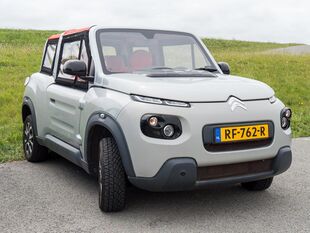Engineering:Citroën E-Méhari
| Citroën E-Méhari | |
|---|---|
 | |
| Overview | |
| Manufacturer | Citroën |
| Production | 2016–2019 (1,000 produced) |
| Model years | 2017–2019 |
| Assembly | France: Rennes (PSA Rennes Plant) |
| Designer | Pierre Authier |
| Body and chassis | |
| Class | Mini SUV |
| Body style | 2-door convertible SUV |
| Layout | Front-engine, Front-wheel drive |
| Platform | Blue Summer |
| Related | Bolloré Bluesummer Citroën C4 Cactus |
| Powertrain | |
| Electric motor | 50 kW (68 PS; 67 hp)[1] |
| Transmission | 1-speed fixed-gear [1] |
| Battery | 30 kWh lithium polymer[1] |
| Electric range | 200 km (120 mi) NEDC (urban) 100 km (62 mi) (extra-urban)[1] |
| Plug-in charging | 13 hours on home socket (10A), 8 hours on 16A [1] |
| Dimensions | |
| Wheelbase | 2,430 mm (95.7 in)[1] |
| Length | 3,809 mm (150.0 in)[1] |
| Width | 1,728 mm (68.0 in)[1] |
| Height | 1,653 mm (65.1 in)[1] |
| |uk|Kerb|Curb}} weight | 1,405 kg (3,097 lb)[1] |
| Chronology | |
| Predecessor | Citroën Méhari Citroën FAF Citroën Bijou Citroën C3 Pluriel |
The Citroën E-Méhari is a limited-production electric off-road subcompact SUV produced by the France car maker Citroën from 2016. Approximately 1,000 cars were planned to be produced in collaboration with the French electric car producer Bolloré.[2] Sales began in France in spring 2016 with pricing starting at €25,000 excluding the battery leasing.[3] It reaches a top speed of 110 km/h (68 mph) and accelerates 0–50 km/h (0–31 mph) in 6.4 seconds.[1][needs update]
The E-Mehari is based on the Bolloré Bluesummer, and references the original Citroën Méhari from 1968 in both name an design, featuring a fabric roof and hose down interior. Citroën were reported to be concentrating sales on the rental car market in Southern Europe, particularly around coastal areas. [4]
References
- ↑ 1.00 1.01 1.02 1.03 1.04 1.05 1.06 1.07 1.08 1.09 1.10 "Citroën E-Mehari - Caractéristiques techniques et équipements" (in fr). http://data.citroen.fr/Resources/Content/FR/Brochures/VP/CT/CT_E-MEHARI.pdf?_ga=1.237851456.1178147283.1457196703.
- ↑ Pander, Jürgen (2016-03-04). "Elektroautos in Kleinserie - Zum Knutschen" (in de). Spiegel.de. http://www.spiegel.de/auto/aktuell/elektroautos-auf-dem-genfer-autosalon-wir-verzichten-a-1080490.html.
- ↑ "Citroën E-MEHARI - Citroën FR" (in fr). Citroen.fr. http://www.citroen.fr/vehicules-neufs/futurs-vehicules/citroen-e-mehari.html.
- ↑ Read, Dan (19 March 2016). "First drive: Citroen's e-Mehari, a convertible electric car". https://www.topgear.com/car-reviews/e-mehari/first-drive.
External links
Template:Citroën timeline 1980 to date
 |


